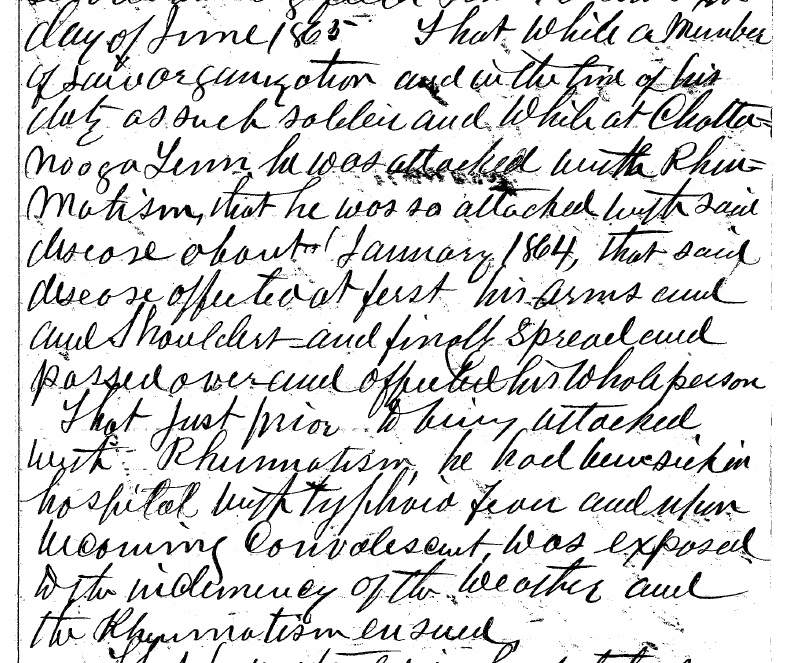When we last left off, Salathiel had contracted Typhoid Fever sometime around the time of the Battle of Chickamauga (September 18-20, 1863). He spent several months in a hospital and then returned to his unit on March 22, 1864.
When he later applied for a disability pension, he claimed that it was during this hospitalization that he contracted the “rheumatism” which plagued him for the remainder of his life. From his pension application, his lawyer wrote:
“…that while a member of said organization and in the time of his duty as such soldier and while at Chattanooga Tenn. he was attacked with Rheumatism, that he was so attacked with said disease about January 1864, that said disease affects at first his arms and shoulders and finally spread and passed over and affected his whole person. That just prior to being attacked with Rheumatism, he had been sick in hospital with Typhoid Fever and when becoming convalescent was exposed with inclemency of the weather and the Rheumatism ensued.”

Salathiel’s medical records (we’ll delve into them more later on) show that he not only suffered from joint inflammation, which he called ‘rheumatism’, but also an enlarged heart and periodic bouts of ‘aphonia’ (severe laryngitis).
Because Typhoid is treatable with antibiotics today, there is not a lot of information in the modern medical literature about the long-term complications from Typhoid Fever. I did find an old 1909 medical book (available on Google Books) that shed some light on the progress of the disease. Joint inflammation is a typical side-effect of Typhoid Fever. Typhoid Fever can set off many septic (infection) processes throughout the body, including the joints, the heart, and other organs. The ‘aphonia’ is also a classic Typhoid after-effect. The disease can paralyze the laryngeal tissues (vocal cords) and can also create lesions in the larynx.
Salathiel’s disability claim suggests that the Rheumatism came along as a result of cold weather during his convalescence, as though Rheumatism was a condition separate from Typhoid Fever. Obviously I’m not a doctor, but it really seems to me that all of his life-long symptoms were directly attributable to Typhoid Fever.
Salathiel never gave up, though – he persisted in his military service until the end of the war, despite multiple hospitalizations. He was even granted a furlough at one point. I don’t know how effective he was as a soldier after March, 1864. By the end of the war, he followed along in the wagon train and was not able to keep up with his Company.
Next time, we’ll resume the chronology and find out more about Salathiel’s battle experiences and hospital stays.
